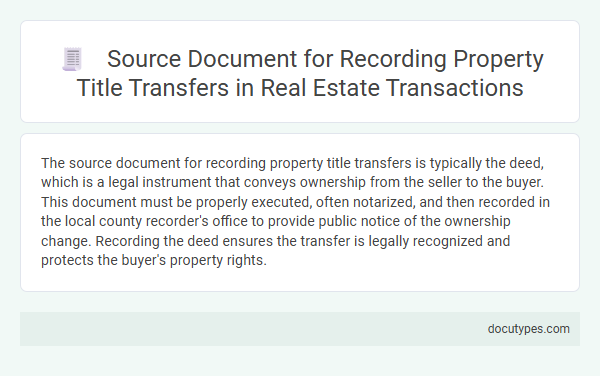The source document for recording property title transfers is typically the deed, which is a legal instrument that conveys ownership from the seller to the buyer. This document must be properly executed, often notarized, and then recorded in the local county recorder's office to provide public notice of the ownership change. Recording the deed ensures the transfer is legally recognized and protects the buyer's property rights.
Introduction to Source Documents in Property Title Transfers
Source documents are essential in recording property title transfers, as they provide the legal basis for ownership changes. These documents include deeds, titles, and sale agreements that ensure the transfer is officially recognized. Understanding the role of these source documents helps you protect your property rights and verify ownership history.
Importance of Source Documents in Real Estate Transactions
| Aspect | Details |
|---|---|
| Source Document Definition | The source document for recording property title transfers is typically the deed, a legal instrument that conveys ownership from the seller to the buyer. |
| Types of Deeds | Common types include warranty deeds, quitclaim deeds, and grant deeds, each providing different levels of guarantee and protection to the buyer. |
| Role in Title Transfers | The deed serves as the primary evidence of ownership and must be recorded in public records to formalize the transfer and protect the new owner's rights. |
| Importance of Recording | Recording the source document ensures legal recognition of ownership, prevents disputes, and maintains clear public records for future transactions. |
| Supporting Documents | Other essential source documents include the title report, mortgage documents, and settlement statements, which provide additional verification and details of the transaction. |
| Legal Requirements | State and local regulations dictate specific procedures for recording documents to ensure compliance and protect all parties involved in the property transfer. |
| Impact on Real Estate Market | Accurate and accessible source documents increase transparency, facilitate secure property investments, and contribute to market stability. |
Types of Source Documents Used in Property Title Transfers
Source documents for recording property title transfers serve as the legal proof of ownership change. These documents are essential in ensuring the transfer is recognized and legally binding.
The primary types of source documents include deeds, such as warranty deeds and quitclaim deeds. Other documents like title assignments and court orders may also be used depending on the transfer context.
Legal Requirements for Property Transfer Documentation
The source document for recording property title transfers is the deed. This legal document serves as the official record that conveys ownership from the seller to the buyer.
Legal requirements for property transfer documentation include a properly executed and notarized deed, which must be filed with the local county recorder or land registry office. Your signature on the deed confirms the transfer, ensuring it is legally binding and enforceable.
The Role of Deed in Recording Property Ownership
The source document for recording property title transfers is the deed. This legal instrument serves as the primary record that officially documents the transfer of ownership from the seller to the buyer. Your ownership rights are established and recognized through the recording of the deed with the appropriate government office.
Essential Information Included in Property Transfer Documents
The source document for recording property title transfers is typically the deed. This legal document officially conveys ownership from the seller to the buyer.
- Grantor and Grantee Information - The deed includes the full names and addresses of the parties involved in the property transfer.
- Property Description - A detailed legal description of the property being transferred is essential for identification and recording.
- Signatures and Notarization - The deed must be signed by the grantor and notarized to validate the transfer and enable official recording.
Verification and Authentication of Source Documents
The source document for recording property title transfers is typically the property deed, which serves as the legal proof of ownership transfer. Verification and authentication of these documents are critical to ensure the validity and accuracy of the transaction.
- Deed Verification - Confirming the deed is properly executed, signed, and notarized according to state laws.
- Title Search - Conducting a detailed title search to verify the property's ownership history and check for liens or encumbrances.
- Authentication by Registrar - Official authentication through the county recorder or land registry office to validate the document's legitimacy.
Ensuring these verification steps are followed protects both parties and maintains clear property ownership records.
Common Issues with Property Title Transfer Documentation
The source document for recording property title transfers is the deed, which legally conveys ownership from the seller to the buyer. Accurate documentation is crucial to ensure clear property title and avoid future disputes.
- Incomplete Information - Missing details like buyer or seller names can invalidate the title transfer process.
- Improper Notarization - Failure to notarize the deed can cause it to be rejected by the recording office.
- Recording Delays - Late submission of the deed to the county recorder can result in ownership disputes or lien complications.
Best Practices for Safekeeping Property Title Documents
The source document for recording property title transfers is typically the deed, which serves as the official record of ownership change. This legal instrument must be properly executed, notarized, and recorded with the relevant county recorder's office to ensure validity.
Best practices for safekeeping property title documents include storing them in a secure, fireproof safe or a trusted escrow service. Digital copies, verified by a reliable electronic recording system, provide an additional layer of protection and easy access. It is crucial to keep these documents organized and backed up to prevent loss or damage, safeguarding your property rights.
What Is the Source Document for Recording Property Title Transfers? Infographic

